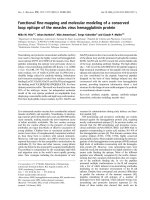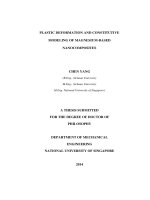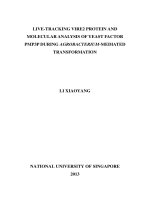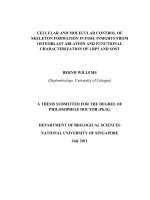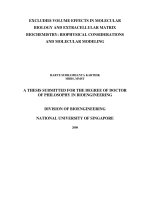Spectral stability study and molecular modeling of fluorence based conjugated polymers 2
Bạn đang xem bản rút gọn của tài liệu. Xem và tải ngay bản đầy đủ của tài liệu tại đây (109.79 KB, 4 trang )
36
CHAPTER 2 EXPERIMENTAL AND CALCULATION
METHODS
37
2-1 Measurements
2-1-1 Ultraviolet -visible absorption spectroscopy (UV-vis)
UV-Vis spectrometer measures the absorption of light in the visible and “near”
ultraviolet region (i.e., in the range of 250-800 nm). As a whole, ultraviolet radiation is
absorbed by a chromophore rather than the molecules. When absorption occurs,
electronic transition of molecule takes place. It is thus particularly suitable for the
study of electronic structure of conjugated polymers, which contain extended π-
conjugated chain and exhibit unusual color changes.
2-1-2 Photoluminescence spectroscopy (PL)
During the process of absorbing ultraviolet or visible electromagnetic radiation,
molecules are elevated to an excited electronic state. Some molecules will emit some
of this excess energy as light of a wavelength different from that of the absorbed
radiation. This process is called fluorescence (photoluminscence), which can be
considered as a deexcitation process that occurs after excitation by photons.
2-1-3 Differential scanning calorimetry (DSC)
DSC measures the heat flow of a sample with increasing temperature, and is a
determinant of exo/endothermic transitions such as glass transition temperature (T
g
),
crystallization temperature and melting point (m.p.).
38
2-2 Semiempirical molecular orbital calculation
Various semiempirical methods could be employed in calculating the desired
parameters. In these methods, calculations are greatly simplified by approximating
certain integrals with parametric functions or by neglecting some of these integrals.
The numerical parameters are usually obtained through fitting calculated properties to
known experimental data, such as heats of formation and ionization potentials, of a
selected set of compounds.
As only a limited set of molecules, for which precisely known experimental
data exist, is chosen for parametrization, the semiempirical approach is therefore not
expected to give good fits in all instances. Nonetheless, semiempirical methods are
widely used because the computational time required for such methods is relatively
short.
Various semiempirical SCF methods with different parametrization schemes
have been developed over the past years.
AM1
(Austin Model 1) was introduced in 1985 with the aim of overcoming
some common defects in MNDO (Modified Neglect of Diatomic Overlap), such as
overestimation of energies for sterically crowded molecules and inadequate description
of hydrogen bonding. The MNDO method tends to overestimate the repulsion between
atoms that are separated by a distance comparable to the νan der Waals distance. By
introducing additional radical Gaussian terms to the core-core repulsion terms, the
inadequacies in MNDO could be reduced.
39
Figure 2.1 shows the flow chart for a typical semiempirical geometry
optimization process. The Fock matrix is generated from empirical parameters.
No
No
Yes
Yes
alculate New Geometry
Print Output
Calculate Other Properties Requeste
d
Optimized ?
Calculate Energy Gradients
?
Achieved
SCF
Solve SCF Equations
Calculate Initial Guess of MO s
Assign Parameters
Read Input Geometry
C
Figure 2.1 Flow chart for a typical semiempirical geometry optimization [Dewar,
M. J. S.; Zoebisch, E. G.; Healey, E. F.; Steward, J. J. P., J. Am. Chem.
Soc., 1985, 107, 3902.]
